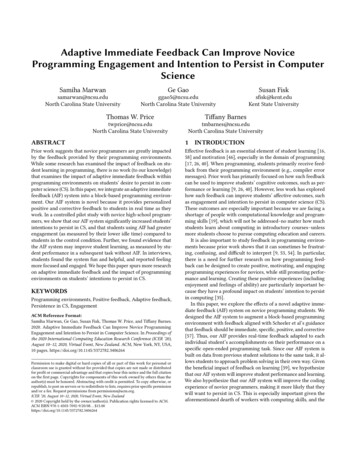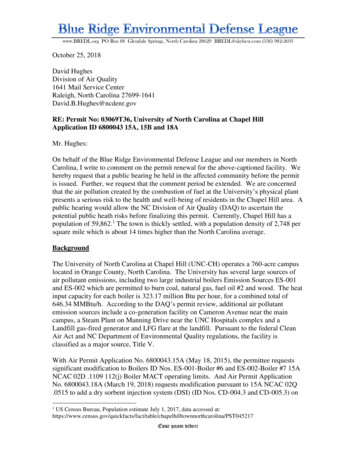
Transcription
Managed CareContracting &ReimbursementAdvisorVolume 11Issue No. 5P4RAC audits moratoriumP5North Carolina Medicaid systemprompts lawsuitCould last two yearsDoctors suing state, vendor, consultantsP7No more delays in ICD-10 dateP7AMA report finds higher ICD-10 costsEnd-to-end testing approvedImpact will be much greater than previously thoughtMAY 2014Physicians fighting UnitedHealthcare’s decisionto drop 2,000 from Medicare AdvantageSkirmish in North Carolina could be harbinger of other state fightsDoctors’ groups are gaining ground in their fightagainst UnitedHealthcare’s decision to remove 2,000providers from its Medicare Advantage networks.A federal judge in Connecticut refused a request tothrow out an injunction prohibiting the payer fromdropping doctors from the networks, and the battlecould signal that doctors don’t have to take these decisions lying down.The lawsuit was filed by the Fairfield County MedicalAssociation and the Hartford County Medical Association in November 2013, and the preliminary injunctionwas issued in December. The most recent court actionis encouraging because it suggests physicians have alegitimate argument that being arbitrarily dropped byUnitedHealthcare could be detrimental to their practices, says Mark S. Thompson, executive director of theFairfield County Medical Association in Shelton, Conn.He notes that the UnitedHealthcare drops firstcame to light when a patient contacted a Connecticut hysician upon hearing that the physician was noplonger part of the Medicare Advantage network. Thephysician had not heard yet that he was being droppedand said the patient must be mistaken.“The physician then called UnitedHealthcare, and arepresentative told him, ‘It’s true, doctor, you’re aboutto be terminated from the Medicare Advantage network,’ ” Thompson explains. “The doctor asked why,but they had no answer and just told him he was to bedropped as of February 2014. He was told he wouldbe getting a letter soon notifying him, and the doctorin turn called us to see if the medical association knewanything about it.”Thompson’s association contacted UnitedHealthcare for an explanation and was told that the companywas poised to drop 2,250 physicians from the network“as part of UnitedHealthcare’s Medicare optimizationprogram.”“It took my breath away,” Thompson recalls. “United
Managed Care Contracting & Reimbursement Advisorwas the largest provider of Medicare Advantage services here in Connecticut, and I couldn’t imagine a company in one fell swoop dropping 2,250 primary careand specialists across the state. This had to be a third oftheir network here in Connecticut.”When Thompson asked why the company was making such a huge move, the representative told him thatUnitedHealthcare “needs to optimize our profitability,”he recalls.“They came right out and said it,” Thompson says.“It all has to do with how these Medicare Advantageprograms are reimbursed by the federal government.As everyone in the industry is being squeezed, so arethe Medicare plans. The actuaries at UnitedHealthcarehad figured out which patients were costing them moremoney and which were costing them less.”UnitedHealthcare could not legally drop the patients,so instead it dropped the physicians treating the older,sicker, more complex patients, according to Thompson.“That’s how the companies are optimizing their profits,” Thompson says. “The physicians’ largest concernwas that they had patients they treated for 20 years andnow they couldn’t treat those patients anymore. Thetiming was terrible, because United didn’t tell patientsuntil mid-October and they had to make a decision byMay 2014December 7. Many patients didn’t know this changewas about to happen to them.”“The actuaries at UnitedHealthcare hadfigured out which patients were costingthem more money and which were costing them less.”—Mark S. ThompsonForcing those patients into other plans could leadto other payers taking on too many high-cost patientsand then taking the same action as UnitedHealthcare,Thompson says. There could be a domino effect in thestate and even across the country, he adds, which is onefear that prompted the medical associations to file suit.The lawsuits are intended not only to bring immediaterelief to the affected Connecticut physicians but also tocontain the UnitedHealthcare strategy before it gainsmomentum among other payers, Thompson says.Payer ordered to consider appealsThe lawsuit seeks to stop UnitedHealthcare fromarbitrarily dropping the physicians and instead leavingthem on the plan as the parties move to arbitration,which is required by the payer’s contract. Staying onThis document contains privileged, copyrighted information. If you have not purchased it or are not otherwise entitled to it by agreement withHCPro, a division of BLR any use, disclosure, forwarding, copying, or other communication of the contents is prohibited without permission.Neil B. Caesar, Esq.The Health Law CenterNeil B. Caesar LawAssociates, PAGreenville, S.C.EDITORIAL ADVISORY BOARDSenior Director, ProductErin CallahanEditor Greg Freemangafreeman@bellsouth.netFollow UsFollow and chat with us about all things healthcarecompliance, management, and reimbursement.@HCPro IncGary Scott Davis, Esq.McDermott Will &Emery, LLPMiami, Fla.Paul R. DeMuro, Esq.Schwabe, Williamson& WyattPortland, Ore.John M. EdelstonHealthPro Associates, Inc.Westlake Village, Calif.Allan FineThe New York Eye and Ear InfirmaryNew York, N.Y.Robin J. Fisk, Esq.Fisk Law OfficeAshland, N.H.Alice G. Gosfield, JDAlice G. Gosfield &Associates, PCPhiladelphia, Pa.Randi Kopf, RN, MS, JDKopf HealthLaw, LLCRockville, Md.Reed Tinsley,CPA, CVA, CFPReed Tinsley & AssociatesHouston, TexasManaged Care Contracting & Reimbursement Advisor (ISSN: 1533-5453 [print]; 1553-9709 [online]) is published monthly by HCPro, a division of BLR, 75 Sylvan St., Suite A-101, Danvers, MA 01923. Subscription rate: 249/year; back issues are available at 25 each. Managed Care Contracting & Reimbursement Advisor, P.O. Box 3049, Peabody, MA 01961-3049 Copyright 2014 HCPro, a division of BLR. All rights reserved.Printed in the USA. Except where specifically encouraged, no part of this publication may be reproduced, in any form or by any means, without prior written consent of HCPro, a division of BLR, or the Copyright ClearanceCenter at 978-750-8400. Please notify us immediately if you have received an unauthorized copy. For editorial comments or questions, call 781-639-1872 or fax 781-639-7857. For renewal or subscription information, callcustomer service at 800-650-6787, fax 800-639-8511, or email customerservice@hcpro.com. Visit our website at www.hcpro.com. Occasionally, we make our subscriber list available to selected companies/vendors. If youdo not wish to be included on this mailing list, please write to the marketing department at the address above. Opinions expressed are not necessarily those of Managed Care Contracting & Reimbursement Advisor.Mention of products and services does not constitute endorsement. Advice given is general, and readers should consult professional counsel for specific legal, ethical, or clinical questions. Managed Care Contracting& Reimbursement Advisor is not affiliated in any way with The Joint Commission, which owns the JCAHO and Joint Commission trademarks.2HCPRO.COM 2014 HCPro, a division of BLR. For permission to reproduce part or all of this newsletter for external distribution or use in educational packets, contact the Copyright Clearance Center at copyright.com or 978-750-8400.
May 2014the plan during the dispute is crucial, Thompson says,because physicians will be more successful in arguingto stay on the network than arguing to be put back onit. In refusing the payer’s effort to lift the injunction,the judge issued a new 30-day appeal period for allphysicians being dropped by United. Physicians wouldhave this time period to allow filing for arbitrationregarding their termination.A key complaint is that UnitedHealthcare is droppingthe physicians from the network without providing areason, which is a violation of the plan contract, saysThompson.“They told physicians ‘we’re dropping you becausewe can.’ That was the only reason they gave,” he says.“They never expected in a million years that the doctorswould go to court and seek the last stage of arbitration,but some of them were concerned about long-time patients, some wanted a good reason for being dropped,and there were some who just wanted to poke the insurer in the chest a little bit and say they weren’t goingto be pushed around like this. It’s David and Goliath,but so far David is faring very well in all of this.”Dermatologist Robin Oshman, MD, PhD, inNew York also looking atlitigation with UnitedHealthcareConnecticut could be joined by physicians inNew York state who are facing similar dismissal from UnitedHealthcare plans, says Sam L. Unterricht, MD,president of the Medical Society of the State of New York(MSSNY). The New York physicians had sought the sameinjunctive relief, but differing state laws complicated that effort, and MSSNY decided to wait for the outcome in Connecticut. After the recent Connecticut ruling, MSSNY’slawyers approached United’s legal counsel in order to seewhether they were willing to agree to the period of appealand arbitration, since a 30-day appeal could avoid any fur-Managed Care Contracting & Reimbursement AdvisorWestport, Conn., says she and others were frustratedby the lack of cause. Even if the UnitedHealthcare contract allows appeals, without a cause for dismissal thereis nothing to appeal, she explains.“You know that it wasn’t due to the way you practicedbecause they allowed you to stay in their other programs,” Oshman says. “But when they do that, it sendsa message to the patients in the Medicare Advantagenetwork that was a quality problem with your care. Itmars the reputation of the physician and causes a lot ofconfusion among patients.”UnitedHealthcare spokesperson Jessica Pappassays the company’s dismissal of physicians from Medicare Advantage is a response to the changing healthcare landscape, and she expects to see other payersfollow suit.“This is part of the broader transformation that isunderway across the healthcare system,” she says. “It isan environment in which providers, physicians, hospitals, and insurers are being challenged to provide betterways to care for a rapidly growing senior population andto do so in a way that is more efficient and effective.”UnitedHealthcare’s effort to streamline its networks“is ongoing and will continue through the rest of 2014,”Pappas says.Case shows doctors not powerlessRoy W. Breitenbach, JD, an attorney with the lawfirm of Garfunkel Wild in Great Neck, N.Y., is the attorney who argued the case in Connecticut on behalf of themedical associations. He notes that Connecticut wasjust the first state to feel the effects: UnitedHealthcareis now terminating physicians from networks acrossthe country in a similar fashion. The UnitedHealthcarecontracts stated that physicians could be terminatedfrom the payer’s plans only on the provider’s annualrenewal date, he explains, but the payer got around thatrequirement by taking advantage of the contract clausether legal action while providing relief to the affected physicians in New York.UnitedHealthcare refused the offer, and so MSSNY willtake it to a judge in hopes of convincing UnitedHealthcareClarificationThe February issue of MCCRA incorrectly stated that Har-to agree to this concept without having to further litigaterison College is located in Evanston, Ill. The correct locationthe matter, Unterricht says.is Indianapolis. 2014 HCPro, a division of BLR. For permission to reproduce part or all of this newsletter for external distribution or use in educational packets, contact the Copyright Clearance Center at copyright.com or 978-750-8400.HCPRO.COM3
Managed Care Contracting & Reimbursement Advisorallowing it to unilaterally amend the contract.The contracts were amended to remove the physicians from the Medicare Advantage network but leavethem in other UnitedHealthcare plans, Breitenbachexplains. He argued in court that the dismissals violated the Medicare regulations, which require a reasonfor being terminated and a reasonable appeal process.He also argued that the terminations violated the termsof the contract because the right to amend the contractcannot be used to dismiss physicians from a plan.A number of legal sources and attorneys generalMay 2014provided amicus briefs in support of the Connecticutphysicians, Breitenbach notes.“The physicians feel very strongly that this sets agood precedent that United can’t just decide willy-nillyto narrow networks like this,” he says. “We think it hasmeaning beyond Connecticut because United hascontracts across the country in which they’ve tried tobulletproof themselves from any arbitration or appeals.But we have shown that there is a way around that andthere is a way to challenge UnitedHealthcare and getsome traction.” HHHS suspends RAC appeals for two years,impact could be greatHHS recently announced that the backlog on Recovery Audit Contractor (RAC) appeals is so big that it willnot accept any new appeals until it is cleared, whichmay be as long as two years. The effect on physicianpractices could be significant, but there are steps theycan take to minimize the damage.There are more than 460,000 pending appeals, HHSreports. The moratorium will not affect appeals fieldeddirectly by Medicare beneficiaries.The prospect of two years without RAC appeals immediately prompted criticism from the physicians whocould be affected. Daniel Landon, senior vice president ofgovernment relations with the Missouri Hospital Association, wrote a letter to the state’s congressional delegationcalling the moratorium “unconscionable.”“Providers aggrieved by a RAC payment denial—andwho are twice as likely to win the appeal as lose it—areplaced in administrative purgatory for years,” Landonwrote. “There is no conceivable way this can constituteadequate due process.”The potential effect on physicians is huge, says Robert Magnuson, principal advisor with ImpactAdvisors, a healthcare information advisory services firmin Napersville, Ill. The audit firms can reach back threeyears and examine sets of particular claims that may beincorrectly billed, which can add up to a significant number of targeted bills for a physician practice. Once theydiscover potentially incorrectly billed claims, the RAC4HCPRO.COMfirms will seek a “take-back” from the provider for theincorrect billing. The RAC firms have a built-in collectionincentive that allows them a portion of the recovery.The backlog is essentially caused by two factors,explains Magnuson. First, RACs have examined a hugevolume of claims. In turn, they have sought a largenumber of take-backs. This large volume of claims hasmade the appeal process a burden for the provideradministrative and clinical staff. Second, the providershave often sought the assistance of private firms thatspecialize in contesting these claims.“Thus, you have a situation where the RACs are likelyseeking take-backs for too many claims, since a majorityare won on appeal, and at the same time the providersare likely contesting too many claims. Many providers arecontesting every claim,” he says. “The Administrative LawJudges are overwhelmed with the volume of appeals. Themoratorium by HHS is designed to loosen the load on theAdministrative Law Judges.”The moratorium's effect on physician practices willdepend on the percentage of Medicare patients, notesMagnuson. Another risk, however, is that other payersmay follow HHS' lead. The insurance companies havealways done third-party audits, but Magnuson says heis seeing a big upswing in audits now that HHS and theRACs have found so many supposed overbillings.Physicians covered by hospital billing, such as emergency physicians and specialists, could see more impact 2014 HCPro, a division of BLR. For permission to reproduce part or all of this newsletter for external distribution or use in educational packets, contact the Copyright Clearance Center at copyright.com or 978-750-8400.
May 2014from the moratorium, Magnuson says. Hospitals may behit harder by the audit delays than physicians, he says.In the meantime, Magnuson suggests that physicianpractices assess their dependence on Medicare billing andhow much they have been appealing RAC audit results inthe past. If a significant amount of money is tied up in contested take-backs—and particularly if a practice has beendepending on a regular percentage of those appeals beingpaid—that practice may need to plan for reduced revenuefor the next two years or so. There is no reason to think thatthe percentage of appeals won by physicians will be different after the moratorium is lifted, but those eventual fundswill be significantly delayed.Managed Care Contracting & Reimbursement Advisor“The Administrative Law Judgesare overwhelmed with the volumeof appeals. The moratorium by HHSis designed to loosen the load on theAdministrative Law Judges.”—Robert Magnuson“I’m loath to predict if we will have a solutionany sooner than that, but we certainly need one,” Magnuson says. “This moratorium is putting additionalpressure on providers who already are being hit hardfinancially.” HMedicaid billing so bad that North Carolina doctorssue everyone—state, vendors, consultantsDoctors are suing North Carolina over the state’s Medicaid billing system, in addition to targeting a softwarevendor and consultants, claiming that complications anderrors in the billing system resulted in financial losses tophysician practices and harm to patients.Seven medical practices filed suit against the stateDepartment of Health and Human Services (DHHS);Computer Sciences Corporation (CSC), the companythat built and operates the Medicaid billing system;SLI Global Solutions, a consulting company thattested the system; and Maximus Consulting Services,which conducted independent reviews. The practicesasked the court to be certified as a class that wouldrepresent the state’s 70,000 Medicaid providers.Known as NC Tracks, the Medicaid billing systemhas been widely criticized in news reports, state audits, and legislative hearings. The lawsuit states that,“The proof of CSC’s wrongdoing was the disastrousstate of the software upon go-live. Medicaid providers experienced hundreds of problems with NCTracks, and the system could not reliably perform itscore function of processing reimbursement claims.”The state auditor released a report in 2013, beforethe state started using NC Tracks, questioning thevalidity of the testing regimen. A December audit notedmore than 3,200 deficits in the system since July 1;800 of those deficits had not been fixed by the end ofthe year. DHHS released a statement saying it couldnot comment on the lawsuit other than to point outthe system had fewer problems than other systems ofsimilar size and complexity. The software and billingcompanies denied comment other than to say the lawsuit was without merit.The software system went live on July 1, 2013, andphysicians saw an immediate drop in reimbursement,says Camden R. Webb, JD, an attorney with the lawfirm of Williams Mullen in Raleigh, N.C., who is representing many of the physicians suing the state. Someproviders were not being paid at all; others saw inconsistent or partial payments on certain codes but none onother codes.“It all seemed to be traceable back to something being wrong with the software system the state bought,”Webb says. “The implementation really got off track. Itappeared that most of the parties involved in the implementation knew this thing wasn’t going to work, butthey still went ahead with the implementation anyway.Doctor’s practices are hit worse than anyone else.”About 62% of physician practices in North Carolinareport they are receiving accurate reimbursements,compared to 80% of hospitals and 75% of pharmacies,Webb says. Some physician practices have been hit so 2014 HCPro, a division of BLR. For permission to reproduce part or all of this newsletter for external distribution or use in educational packets, contact the Copyright Clearance Center at copyright.com or 978-750-8400.HCPRO.COM5
Managed Care Contracting & Reimbursement Advisorhard that up to half of their revenue has disappearedfor months, with no indication of when it will resume,he says.In addition, those practices are incurring expensesfrom the significant administrative time required toaddress the problem, employee overtime, and lostclinical time. “We know of a few practices that justclosed their doors completely,” Webb says. “The realshame of it is that some of the practices just decidednot to take Medicaid anymore. One of the biggest OBGYN practices in the state decided not to take Medicaid anymore because of all this trouble, and that’s areal detriment to the people of the state who need thatMedicaid care.”Other states could follow same pathThe case could have implications for physician practices outside North Carolina, Webb says. The disputein that state is specific to the Medicaid software system developed there, but Webb suggests that similarproblems could arise with another state’s system. Theoutcome of the North Carolina suit could influencehow those states address their software issues, hesays.Even if the software was fixed and worked reliably,North Carolina physicians would not be made whole,Webb says. In addition to a 3% decrease in paymentfor some specialists, one of the bones of contentionin North Carolina is how the state abruptly changedthe reimbursement for dual-eligibles on July 1, 2013,when the new system went live. Physicians werereimbursed significantly less than under the previoussystem, and Webb says the financial impact has beenenormous.“Some primary care physicians can decline Medicaidand avoid that hit, but other specialists have to takethose patients and they’re just being massacred,” Webbsays. “They take the patient and the state shorts themon reimbursement to save some money on Medicaid.But they made these changes without going throughthe proper procedures.”The North Carolina lawsuit is more a political statement than a legal maneuver, says Martin Bienstock, JD, partner with the law firm of Weisbrod Matteis & Copley in Washington, D.C. Martin is a6HCPRO.COMMay 2014f ormer assistant attorney general and senior legal advisor to the Governor of New York, and special counsel tothe New York Department of Health, where he draftedand negotiated dozens of state laws and implementedstatewide regulatory enforcement efforts impactingmore than 100 healthcare institutions statewide.“The implementation really got off track.It appeared that most of the partiesinvolved in the i mplementation knewthis thing wasn’t going to work, but theystill went ahead with the i mplementationanyway. Doctor's p ractices are hit worsethan anyone else.”—Camden R. Webb, JDThe state presumably already wants to pay the Medicaid reimbursements but can’t because the softwaresystem doesn’t work, Bienstock says. A judge’s order topay won’t fix the software, but the threat of sanctions,judgments, and bad publicity may add extra incentiveto get moving on a solution, he says.“This isn’t that different from the Obamacare rollout, where the initial system was deeply flawed aftertwo years of preparation,” Bienstock says. “Then thepresident said we were going to fix it, and that addedthe momentum to actually get it done rather than a lotof officials talking about it and passing the responsibility on to one another. That’s what the North Carolina physicians are hoping for, a judge who can putsome motivation into the people responsible for fixingthe software.”Bienstock suggests that the type of legal actionpursued in North Carolina is not advisable for theindividual physician practice that is frustrated withthe state’s billing and reimbursement system. “It’sonly when you have a systemic problem like theyhave in this state, then the most affected providerscan band together and pursue a remedy,” he suggests. “You don’t take that approach when theproblem is practice-specific, but the scope of thesesoftware systems is such that you can have a statewide problem that requires a lawsuit that sends ashot across their bow and gets a court involved tohelp solve the problem.” H 2014 HCPro, a division of BLR. For permission to reproduce part or all of this newsletter for external distribution or use in educational packets, contact the Copyright Clearance Center at copyright.com or 978-750-8400.
May 2014Managed Care Contracting & Reimbursement AdvisorNo more delays for ICD-10, but yes toend-to-end testingThe move to ICD-10 will not be delayed again,according to CMS Administrator Marilyn Tavenner.However, CMS has listened to one of the strongestrequests from the healthcare community and agreedto conduct end-to-end testing before the systemgoes live.The nationwide conversion to the ICD-10 family ofdiagnostic and procedural codes will be implementedas planned on October 1, 2014, Tavenner said recentlyin her keynote address at the Healthcare Information and Management Systems Society convention inOrlando, Fla.“There are no more delays, and the system will golive on October 1,” she said. “Let’s face it guys, we’vedelayed this several times and it’s time to move on.”There also will be no rollback of compliance datesfor stage 2 meaningful use compliance, Tavennersaid. Providers had been petitioning for a delay in thecompliance dates and more flexibility instead of the “allor nothing” approach to determining compliance. July1, 2014, is the last compliance date for beginning a 90day proof of meaningful use.CMS did give in to the many demands for end-to-endtesting of ICD-10 codes before implementation. Aftermuch resistance, CMS recently reversed its policy andannounced it will initiate end-to-end testing of Medicare claims using the new ICD-10 diagnostic codes.End-to-end means the new codes will be tested all theway through the reimbursement system, from providerto payer and through all the intermediaries.The decision was praised by Susan Turney, MD,MS, FACP, FACMPE, president and CEO of MGMA,which had pushed for the testing.“MGMA urges CMS, however, to expand the scope ofthis testing approach to include any provider whowishes to test with them, as well as quickly disseminating results from all Medicare and Medicaid testingefforts,” Turney says. “This more robust testing isimperative to identify potential operational problemssimilar to what was experienced with the rollout ofhealthcare.gov. At the same time, it will help to decrease the potential of catastrophic cash flow disruption that could impact the ability of practices to treatpatients.” HAMA study predicts higher ICD-10 costs thanexpectedThe mandated implementation of the ICD-10 codeset will be dramatically more expensive for most physician practices than previously estimated, according toan updated cost study initiated by the AMA and conducted by Nachimson Advisors.The 2014 study found that in some cases, the estimated ICD-10 implementation costs are nearly threetimes higher than the previous predictions containedin a landmark 2008 study, also produced by Nachimson Advisors.The federal government requires the healthcareindustry to transition to the ICD-10 code set for reporting diagnoses on all healthcare claims and othert ransactions as of October 1, 2014. Implementing ICD10 will result in a fivefold increase in diagnosis codesfrom the current 13,000 codes to a staggering 68,000codes—a massive administrative and financial undertaking for physicians who are already overwhelmed byoverlapping regulatory requirements and uncertaintyin a rapidly changing healthcare landscape.In light of the study findings, the AMA recently senta letter to HHS Secretary Kathleen Sebelius asking herto again reconsider the ICD-10 mandate.“The markedly higher implementation costs forICD-10 place a crushing burden on physicians, straining vital resources needed to invest in new health care 2014 HCPro, a division of BLR. For permission to reproduce part or all of this newsletter for external distribution or use in educational packets, contact the Copyright Clearance Center at copyright.com or 978-750-8400.HCPRO.COM7
Managed Care Contracting & Reimbursement Advisordelivery models and well-developed technology thatpromotes care coordination with real value to patients,”said AMA President Ardis Dee Hoven, MD, in the letter. “Continuing to compel physicians to adopt this newcoding structure threatens to disrupt innovations bydiverting resources away from areas that are expectedto help lower costs and improve the quality of care.”In 2008 the predicted cost to implement ICD-10ranged from 83,290 for a small practice, 285,195 fora medium practice, and 2,728,780 for a large practice.Based on new information, the 2014 study found thefollowing cost ranges for each practice size based onvariable factors such as specialty, vendor, and software: Small practice: 56,639– 226,105 Medium practice: 213,364– 824,735 Large practice: 2,017,151– 8,018,364Two-thirds of physician practices are projected to fallinto the upper range of current cost estimates, whichMay 2014are considerably higher than the 2008 estimates. Thesepractices are expected to incur major costs associatedwith software upgrades to accommodate the transitionto ICD-10. In addition to software upgrades, the totalcosts include the expense of training, practice assessments, testing, payment disruptions, and productivityloss for physicians.The 2014 estimates include much higher figuresdue in part to significant post-implementation costs,including the need for testing and the potential riskof payment disruption. CMS has estimated that claimdenial rates could increase 100%–200% in the earlystages of coding with ICD-10.Costs are not the only challenge facing physicians inICD-10 implementation. Data shows that
Center at 978-750-8400. Please notify us immediately if you have received an unauthorized copy. For editorial comments or questions, call 781-639-1872 or fax 781-639-7857. For renewal or subscription information, call customer service at 800-650-6787, fax 800-639-8511, or email customerservice@hcpro.com. Visit our website at www.hcpro.com .











